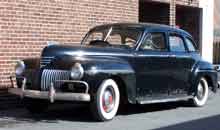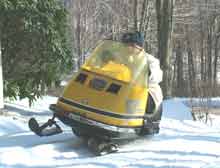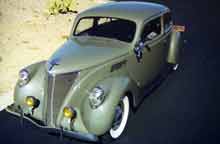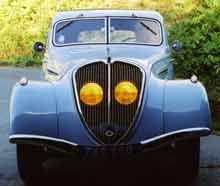Driving DeSotos
Frank McMullen's DeSoto is not a trailer queen. It's not even a beauty queen, and he likes it that way. His 1941 S-8 Deluxe sedan is one of two older cars he uses as daily drivers (the other being a 1960 Chrysler Windsor). Re-painted and re-upholstered by some previous owner, it's otherwise unrestored and turned 100,000 miles not long ago. Frank drives it more than 3,000 miles a year.
As a driver it's kept in good mechanical condition. Frank rebuilt the braking system when he bought it eight years ago. He's currently contemplating an engine swap, as an interim measure while he rebuilds the original powerplant. Mopar heart transplants are fairly straightforward, as the four ChryCo siblings share a lot of DNA. Frank's 228 cubic inch S-8 engine is a shorter stroke version of the six used in 1940-41 Chryslers. In fact, any later Chrysler or DeSoto six through 1954 is a bolt-in, as the differences were all internal. A later engine could be as large as 264 cubic inches; engines from 1949 on have full-flow oil filters.
Frank's DeSoto is driven, but not as much as Jon Robinson's 1950 Custom Club Coupe. Jon has put 170,000 miles on it since purchase in 1990, when the odometer read 72,000. For nearly four years it was his only car. He lives in California's Mojave Desert, which means the car sees plenty of hot weather, and he's driven it to western Washington State, Minnesota, Wisconsin and Texas. The farthest east he's taken it is Albemarle, North Carolina.
Reportedly the car was a mint, low-mileage original until 1982. Thereafter it suffered both body damage and mechanical deterioration, to the point where every exterior panel was scarred. The body and paint were restored in 1993; the engine has been rebuilt three times. It's currently running a 1953 251 cid unit because, according to Jon, "it happened to be available." He's found that a 1957 Dodge rear axle, with 3.36 gears, gives his DeSoto much longer legs for distance travelling. He figures he's saved the drive train some 44 million revolutions over the years.
I can't compete with Frank or Jon. My only DeSoto, a 1940 S-7 Custom purchased for $30 in 1960, didn't get driven very much. In the process of repairing a blown head gasket, I did a much-needed valve job but discovered other internal injuries beyond my skills and my pocketbook. I retreated to the family Nash Rambler. The DeSoto became an organ donor, helping to restore cars from Massachusetts to Texas.
The windmills in the background of Jon's pix are in the Tehachapi Mountains that separate the Mojave from the San Joaquin Valley. They provide an apt simile for the DeSoto: Driven like the Wind.
Tomorrow evening will mark the first anniversary of the CarPort. I'd like to thank Joris of PreWarCar.com for inspiration, Dave of DeSotoLand for helping me get started, and my son Nick for showing me the joys of html. Happy New Year!




